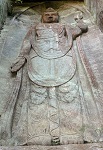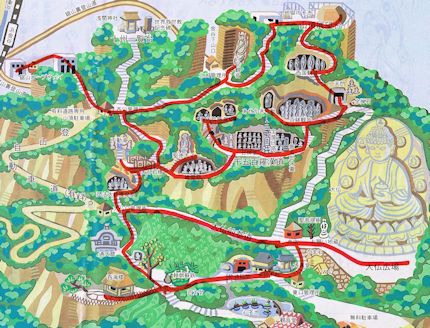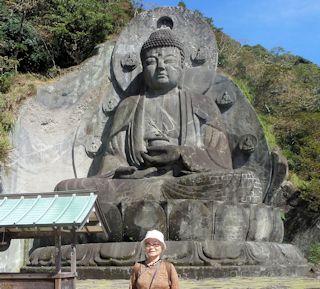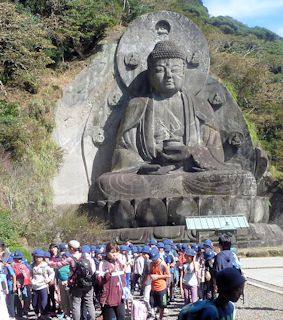|
Every Japanese temple has a mountain name before the temple name.
Nihonji Temple's mountain name is "Kenkon-zan" (Mt. Kenkon),
though I had really thought it was Nokogiri-yama (Mt. Nokogiri) as Nihonji
lies on Mt. Nokogiri.
Therefore or not, in the pamphlet of the temple's administration, its official
name is " Nihonji Temple of Mt. Kenkon at Mt. Nokogiri in Chiba".
In some TV program, the reporter stated firmly "Mt. Nokogiri is Nihonji
Temple itself". Taking the words true, I associated it with Enryakuji
Temple I visited this March, because Mt. Hiei there is Enryakuji Temple
itself opened by Priest Saicho in Heian period (794-1185).
Enryakji is explained like the way dividing Mt. Hiei to 3 areas: Todo (East
Tower) with Konpon-chudo Hall (Main Hall) in the center, Saito (West Tower)
with Shaka-do in the center, and Yokawa originated by Priest Ennin.
That is to say, I expected Nihonji Temple was also the complex of such
halls dotted here and there each of which gave us mercy. My expectation
was totally wrong.
No such great buildings like Konpon-chudo Hall were found, and I wondered
if there were any other prestigious buildings.
The biggest cause of this situation must have been the fire in 1939. Most
of the halls, temples and precious statues of Buddha were burnt down and
only a few of them have been restored until now. The restoration speed
has been so slow perhaps because of lack of budget. What are our country
and Chiba Prefecture thinking about it?
Such message was found both in the pamphlet and the signboards here and
there as "To every visitor here: please donate some for the restoration
of Nihonji Temple. ....". I read Nihonji was repairing all of what
used to be by itself relying on the donation of believers, residents and
tourists, from the message.
 I know I have already mentioned this, but the approaches to Nihonji Temple
were not such an easy mountain pass. I know I have already mentioned this, but the approaches to Nihonji Temple
were not such an easy mountain pass.
I wrote about Hundred-shaku Kannon near the west entrance in the previous
chapter. It is the carved-stone sculpture on the steep rock wall, spent
6 years until its completion in 1966.
From around there, the pass was a rocky stretch with full of ups and downs.
Our tour of Nihonji Temple began from the top of Mt. Nokogiri 10 minutes
from Hundred-shaku Kannon. Just before, I believed there was the main hall
of Nihonji like Konpon-chudo Hall of Enryakuji Temple. Now I know it was
my mistake.
Our couple decided to walk, aiming at Yakushi Main Hall, because it seemed
to be the most dignified building.
Looking back our tracing to and from the west entrance, it is like the
following map.

The main scenic spots are as follows.
View of Hell
You can notice the remains of the old quarry on the rock face cut vertically.
The tip of a rock sticks out up from the vertical face around the mountain
top (above Hundred-shaku Kannon).
It requests you a considerable courage to look down into the bottom from
there. (Kyonan Town) |
It already looked to be the first step to "Hell" to climb to
the obsevatory viewing into the hell.
"I will wait here," said Emiko naturally who had a little trouble
on her knees.
I climbed up the cliff hard holding the rail on one side, and finally reached
the observatory.
Yes, it was a wonderful landscape on the cliff top. Feeling weak at the
knees, I could view further the panorama and look straight down into the
hell.
I did not feel an extra fear there as it was stable at my feet in spite
of the rain the previous day.
I felt much weaker at the knees when I turned round and looked down the
bottom of the steep slope where Emiko was waiting.
Paying exactly the most prudent attention, I got down slowly and carefully.
The Fifteen Hundred Rakan Disciples
The 1,553 small statues of Rakan disciples of Buddha were made by Jingoro
Ohno, a master craftsman, and his 27 apprentices spending for 21 years
from 1779, to realize the wish of the 9th high priest Kouga Guden of Soto
Sect. They were set up among strangely shaped rocks and caves.
The huge numbers of the statues in this temple surpass those in Daichu
Temple in China which used to be the first in the world.
--------
Regretfully they have fallen into ruin through until now since the movement
to abolish Buddhism in Meiji period. We are trying to restore them, to
tie heads to bodies first. (Office of Nihonji Temple) |
From where to where does the Rakan Road go?
My understanding by walking around is: the starting point is Saigoku Kannon
seen after stone steps and natural slopes from the View of Hell and it
ends at Goma-kutsu (Goma Cave) with Great Priest Kobo-daishi sitting in
the center.
Exactly Rakan statues on parade. But sadly most of the statues were without heads as the office pamphlet mentioned. I wondered if they might have been neglected for a long time until now. I came to wish they would possibly be repaired in the near future.
The slopes with signboards of "Rakan Road" were comparatively
flat, but the most area around was not easy going either. I have to confess
I only walked forward gasping for breath, and barely took pictures of evidence.
Though I noticed the Fudo Falls up from Cave Goma, no power left to get
there.
Stone Statue of Great Buddha

This statue was originally built in Edo period (in 1783), but left collapsed
during 1850s-60s by natural erosions for more than a century.
It was reproduced in 1969 by the restoring construction for 4 years. The
official name is Yakushi-ruriko-nyorai.
The height is 31 meters, compared with the Great Buddha of Todaiji Temple (18 meters) and that of Kamakura (13 meters). |
We visited the statue both to and from the approach.
In coming back, Emiko wanted to take a rest there and sat on a bench probably
because she came up with some haiku poem. I took pictures around the statue
as usual. School children gathered together to have a souvenir photo taken.

- - - - - - - - - - -
Getting down to the foot by ropeway, such an impression flashed through
my mind.
Mt. Nokogiri should be a hiking course with spirits rather than the sacred
mountain of Nihonji Temple.
The main reason is that most of the buildings including Buddha statues
and halls were burned down in the fire in 1939 all right, but I did not
feel in Mt. Nokogiri the atmosphere of the sacred temple mountain with
long history since it had been built by Priest Gyoki at the order of Emperor
Shomu in 725.
On the contrary, the precincts of Nihonji Temple with too many ups and
downs were exactly a tough hiking course at least for me partly because
of the aftereffects of the fire. Moreover, I realized, it was the roads
to give the achievement of love to young people and some quality time to
families. Above all, I really felt these strict areas were particularly
where anyone could confess his/her thought to his/her beloved.
Climbing steep stone steps, you see statues of Buddha, Kannon and Rakan
on both sides. The calm sea appears before you brilliantly far beyond.
Songs of birds, fresh trees and flowers.
Let out all your feelings, losing your breath, and nothing would be failed.
I guarantee.
Walking around Nihonji Temple somewhat seemed practically impossible to
the elderly and handicapped people, but I noticed there were some other
gentle slopes with no steepness, just for confirmation.
Nothing would ever be tasteful than the rice-ball (onigiri) lunch, worshipping
the Stone Statue of Great Buddha. Young and old alike must have a rich
feeling. The ties of families as well as friends would be made sure in
such an atmosphere.
Enryakuji Temple on Mt. Hiei we visited this March is the temple opened
by Priest Saicho (Dengyo-daishi). Its noted events of severe training have
been continued, like 12-year Rozan (confined in the mountain) and 1,000-time
walking around Mt. Hiei. I felt my prayer answered just putting my hands
together there.
Nihonji Temple on Mt. Nokogiri has changed the sects several times, as
Hoso, Tendai, Shingon and now Soto since Edo period. It has some relationship
with Enryakuji as it experienced Tendai Sect.
Though its sect is the one of salvation by one's efforts, there are no
halls with a piercing look. It rather had a tolerant atmosphere with the
huge Daibutsu statue.
However, might be insistent, the approaching roads. They were honestly
too much to me. But if well prepared beforehand not like myself this time,
Nihonji Temple would give you enough mercy for your present situation,
health condition and what not, showing stone statues along the roads and
the beautiful sea beyond.
Nihonji Temple was sure enough a sacred mountain, on the condition that
it is heart-warming rather than divine.
Pictures at Nihonji Temple
|